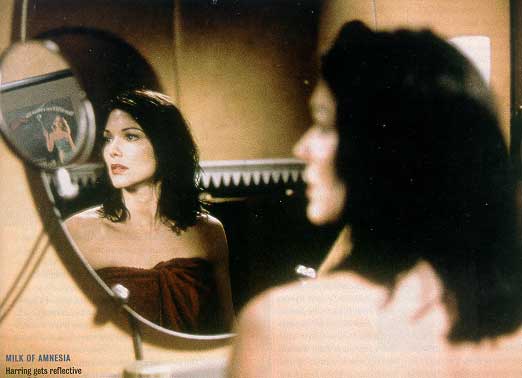
In the Hollywood noir Mulholland Drive, David Lynch takes a hypnotic trip down his own cinematic lost highway.

In the Hollywood noir Mulholland Drive, David Lynch takes a hypnotic trip down his own cinematic lost highway.
By Owen Gleiberman
For all of his Freakshow idiosyncrasy, David Lynch remains one of the last conjurers of the old, you-won't-believe-your-widened-eyes school of cinema: He makes movies that seem to reach out and gather the audience into a dream state of collective awe. There's a scene in Mulholland Drive that works in just that way, and it ranks right up there with Lynchs greatest. We're in deepest, darkest Hollywood, in the offices of a has-been producer, the walls and lighting lush with turpitude (the color scheme is rotting beige). In this '40s- style studio-lot chamber, Betty (Naomi Watts), the latest of Lynch's dimpled blond angel women, as pretty and enthusiastic as a girl in a Hula Hoop contest, ar- rives for her big audition and discovers that she has to perform opposite an aging matinee idol- a smiling lech (Chad Everett) who looks like a decadent B-movie Burt Lancaster, his tan face as cracked as a lizard-skin handbag.
The scene they're enacting is an overheated piece of soap opera noir trash, complete with kinky symbolic incest and potboiler dialogue. The old hack is eager to get on with it, mostly because he'd like to get "close" to Betty and cop a feel. As wholesome as Betty may be, though, she is hardly a dummy. Instead of recoiling, she lets him move in as near as he wants, lips, paws, and all. The two do the entire scene pressed up against each other, their mouths caressing, locking, and then drawing back, the bad dialogue riding on hot breaths, until it all but quivers with lust. Betty, the clean girl doing a dirty scene, is a terrific actress after all. She deliberately turris the old horndog on, shocking and cajoling him by tapping her own desire and disgust, so that what passes between them becomes a fulfillment of the pulp passion they're portraying. For a few moments, Lynch, the wizard of odd, alchemizes the familiar and the tawdry into pure movie poetry.
That's what he does in the rest of the film, too. Except that the cliches he's transforming in Mulholland Drive aren't Hollywood's. They're Lynch's own- the themes and fetishes and motifs that he has parsed and recombined again and again, in Blue Velvet and Twin Peaks, Wild at Heart and Lost Highway. A sinister dwarf delivers cryptic orders from his draped red-velvet hell. A clean-cut man in a brightly lit diner torments and tantalizes himself with fear and dread. There are decayingly gloomy prewar apartments, tree-lined suburban nightscapes, and close-up images of big gnarly ears. There's the sound of a Roy Orbison song crying in the night, and of Angelo Badalamenti's rhapsody-in-black synth music. And there's Betty, who speaks in ironically non-ironic Wonder Bread homilies like "Won't that be the day!" even as she becomes a morally possessed Nancy Drew, counterpoised with a voluptuous damaged dark girl who is up to her neckline in Mystery. In the ultimate Lynch twist, a light girl becomes a dark girl, and the audience, even those of us who were in a trance, grows deeply and powerfully confused.
Mulholland Drive is rapt and beautiful and absorbing, but except for a few scenes, like the one featuring an underworld enforcer known as the Cowboy (Monty Montgomery), who's like a sinister, down-home Zen version of the man in the moon, it lacks the revelatory charge that Blue Velvet had 15 years ago. The new film has been expanded from a two-hour television pilot that got rejected by ABC, and watching it is like strolling through a corridor of the David Lynch fun house: He's become the most deliriously self-referential crafter of Hitchcockian art thrillers since Brian De Palma. Still, I don't want to carp too much. Mulholland Drive may on some level be a sacramental dream as rerun, but Lynch is such a hypnotic craftsman that he holds you in his thrall.
The star, Naomi Watts, looks like a pixie Sharon Stone, and she's an extraordinary talent. As Betty, she gives goodness a dimension of vibratory sensuality, so that we believe in her not just when she's nurturing the sultry, amnesiac "Rita!' (Laura Elena Harring), whom she discovers hiding in the L.A. bungalow that Betty has borrowed from her aunt, but later on, when she falls into Rita's fleshy embrace. Lynch digs right into the intoxicating hunger and anxiety of sex (for him, they're inseparable), though he'd have done well to meld Betty's story more intricately with that of Adam (Justin Theroux), a hot-shot indie-style film director whose latest project gets taken over by its criminal backers.
Mulholland Drive is Lynch's Hollywood Babylon thriller (he casts Ann Miller as an only-in-La-La Land eccentric who's like a fish out of John Waters), and it's seamless right up until the moment when Betty and Rita go to Club Silencio, an after-hours lip-synch performance space that's meant to be cooler and weirder than it is. In a convoluted identity trope inspired by Vertigo by way of Persona, Betty finally turns a magic blue key, sliding down the rabbit hole of an alternate reality, but it's the film, not Betty, that seems to be slipping away The surreal final act is pure frustration - a pretzel that never connects with itself. In essence, it's Lynch trying to inflate a TV pilot with metaphysical significance, and the result is like something still locked up in his head. For most of Mulholland Drive, though, Lynch's head is a more than tantalizing place to be. B+
© 2001 Entertainment Weekly Inc.
Back to the Mulholland Drive articles page.